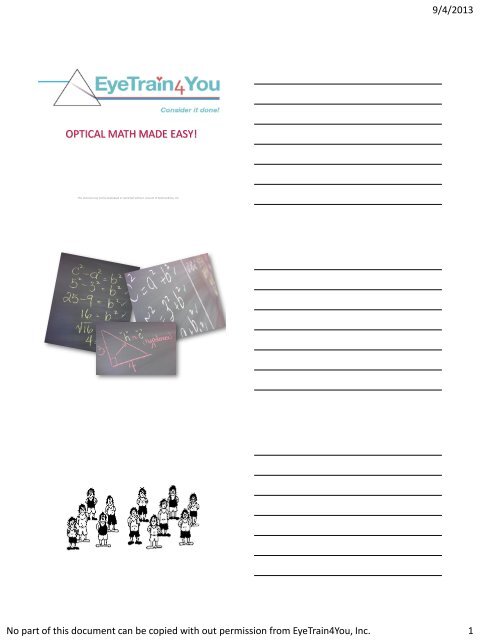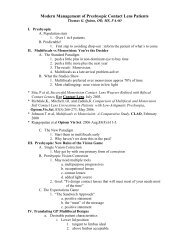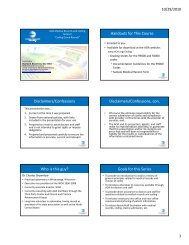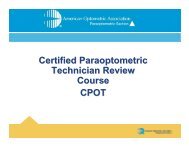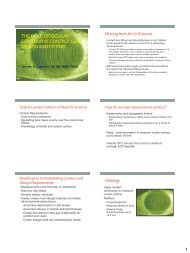Create successful ePaper yourself
Turn your PDF publications into a flip-book with our unique Google optimized e-Paper software.
9/4/2013<strong>OPTICAL</strong> <strong>MATH</strong> <strong>MADE</strong> <strong>EASY</strong>!This material may not be duplicated or reprinted without consent of EyeTrain4You, Inc.No part of this document can be copied with out permission from EyeTrain4You, Inc. 1
9/4/2013Problems Combining a Positive andNegative Numbers?Think about the numbers as if the firstone is the balance in your checkbookand the second one is either adeposit (+) or a debit (-).Problems With the Axis?Easy as pie……180=90 (1+8=9) 90=180 (9-1=8)170=80 (1+7=8) 80=170 (8-1=7)160=70 (1+6=7) 70=160 (7-1=6)Now You Do It1. Rx: +2.50 +1.25 x 0602. Rx: -1.00 +1.75 x 080Transposed:1. +3.75 -1.25 x 1502. +0.75 -1.25 x 170No part of this document can be copied with out permission from EyeTrain4You, Inc. 3
9/4/2013Spherical Equivalent: 2 Steps1. Combine ½ of the cylinder power to thesphere2. Drop the axisLet’s Do ItRx: -1.00 +1.00 x 1801. Combine ½ of the cylinder power to the sphere(+1.00 / 2) =+0.50 Combined with -1.00 = -0.502. Drop the axisSpherical equivalent is: -0.50 sphereNow You Do ItRx: +2.00 -0.50 x 090Spherical equivalent is: +1.50 sphereNo part of this document can be copied with out permission from EyeTrain4You, Inc. 4
9/4/2013Reading Prescription: 1 Step1. Combine the add power with the spherepower. The cylinder and the axis stay thesame.Think About It This WayLens Power is -3.00-1.00+2.00Let’s Do ItRx: -1.00 +1.00 x 180 Add +1.25Combine the add power with the sphere power. The cylinderand the axis stay the same.-1.00 (sphere power) combined with+1.25(add)=+0.25Reading Rx: +0.25 +1.00 x 180No part of this document can be copied with out permission from EyeTrain4You, Inc. 5
9/4/2013Now You Do ItWhat is the reading glasses prescription for thefollowing: +1.00-1.25 x 180+1.25 -1.00 x 175Add +2.00Answer:+3.00 -1.25 x 180+3.25 -1.00 x 175Converting Meters to Feet• 1 m = 3.28 ft.• Divide denominator by 3• 6/6 (6/3=2) so 6/6=20/20• 6/9 (9/3=3) so 6/9=20/30Converting Feet to Meters• It’s easy…just do the opposite• Multiply denominator by 3• 20/20 (2 x 3=6) so 20/20=6/6• 20/30 (3 x 3=9) so 20/30=6/9No part of this document can be copied with out permission from EyeTrain4You, Inc. 6
9/4/2013Lens Power Compared toFocal LengthLens PowerFocal Length0.5 D 2 m (200 cm)1.0 D 1 m (100 cm)2.0 D 0.50 m (50 cm)3.0 D 0.33 m (33 cm)4.0 D 0.25 m (25 cm)5.0 D 0.20 m (20 cm)6.0 D 0.17 m (17 cm )7.0 D 0.14 m (14 cm)8.0 D 0.13 m (13 cm)9.0 D 0.11 m (11 cm)10.0 D 0.10 m (10 cm)The Optical Cross• A spherical lens has one power.• A spherocylindrical lens has one spherical and onecylindrical surface, giving it 2 radii of curve (unequalpower).• An optical cross is used to illustrate the powers of aspherocylindrical lens.Remember: The power of the cylinder is found 90degrees away from the placement of the axis.The Optical Cross+3.00 +1.00 +4.00+3.00 0 +3.00Rx: +3.00 +1.00 x 180No part of this document can be copied with out permission from EyeTrain4You, Inc. 8
9/4/2013The Optical Cross-4.00 0 -4.00-4.00 +1.00 -3.00Rx: -4.00 +1.00 x 090Now You Do It-1.00 +1.00-1.00 0What is the prescription?Prentice’s RuleIf the patient is not looking through theoptical center of a lens that has power, theyare looking through prism.Optical CenterInduced PrismNo part of this document can be copied with out permission from EyeTrain4You, Inc. 9
9/4/2013Prentice’s RulePrism = Power x Decentration in cmPrism = lens power (in diopters) multiplied by D in cm(Where D = amount the patient PD varies from the majorreference point in cm)EX: -4.00 (power) x .5cm (decentration in cm)= 2 prismdioptersDecentration• Plus lens-decentration shifts with the lens– Lens decentered out/induced prism is BO• Minus lens-decentration shifts opposite fromthe lens– Lens decentered out/induced prism is BIPrentice’s RuleWhich direction is the lens decentered?Are the lenses minus or plus?What type of prism is induced?Optical CenterInduced PrismNo part of this document can be copied with out permission from EyeTrain4You, Inc. 10
9/4/2013Now You Do It• Exercise:Rx: OD: +11.00 SphOS: +12.00 SphThe optical centers are both displaced 4 mmtemporally (out)What is the amount and direction of induced prism?AnswerFormula is: Prism = Power x Decentration in cmOD: +11.00 x .4 = 4.4 4 ½ prism diopters (rounded)OS: +12.00 x .4 = 4.8 5 prism diopters (rounded)Prism is base out because with a plus lens, thedecentration shifts with the lens.Low Vision Calculations• To find the dioptric power of a magnifier, multiplythe X power by 4.– Example:– A magnifier that is 10x would be 40 diopters (10 x4 = 40)No part of this document can be copied with out permission from EyeTrain4You, Inc. 11
9/4/2013Low Vision Calculations• To figure the distance that a magnifier should be heldfrom the page to get the clearest image:– Convert the diopters to X by dividing by 4– Divide this number into 10Low Vision CalculationsExample- Where should a 20 D magnifier be held forclearest vision?20/4 = 5 x10/5 = 2 inchesNow You Do ItWhere should a 2x magnifier be held to achieve theclearest vision?10/2=5 inchesWhat is the dioptric power of a 2x magnifier?2 x 4 = 8 DNo part of this document can be copied with out permission from EyeTrain4You, Inc. 12
9/4/2013Test Height CalculationsThe 20/400 E should be88 mm in height ifpatient is 20 feetaway.What if patient is 17 feetaway?20 ft 17 ft88 mm = X mm88 times 17 equals 1496X equals 74.8Now You Do ItWhat if thepatient is 15feet away?20 ft 15 ft88 mm X mm88 times 15 equals 1320X equals 66 mmNo part of this document can be copied with out permission from EyeTrain4You, Inc. 13


